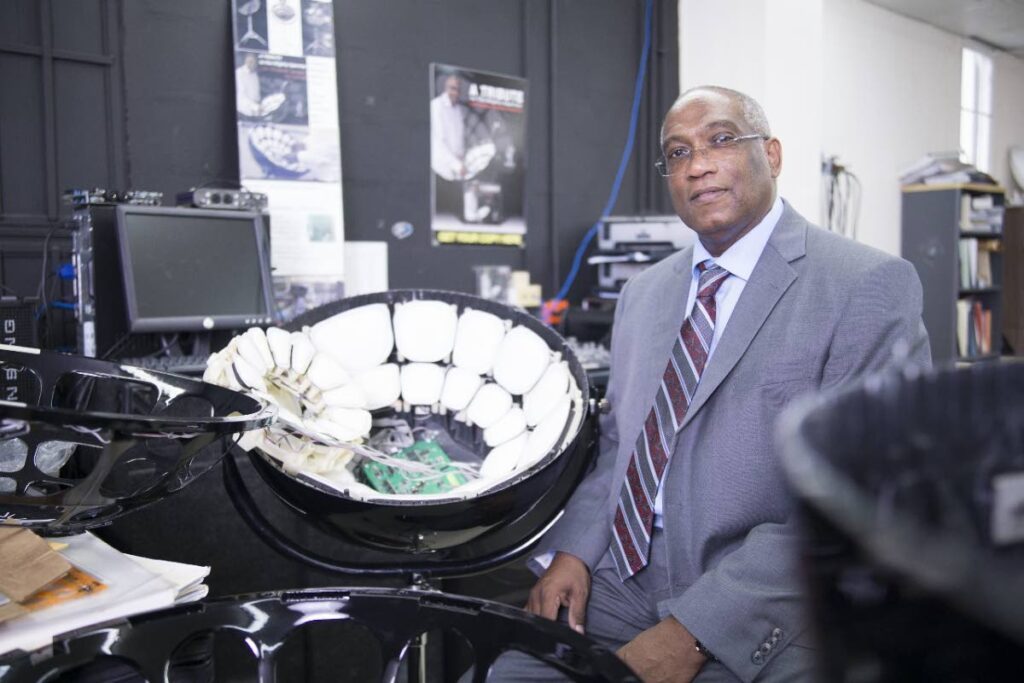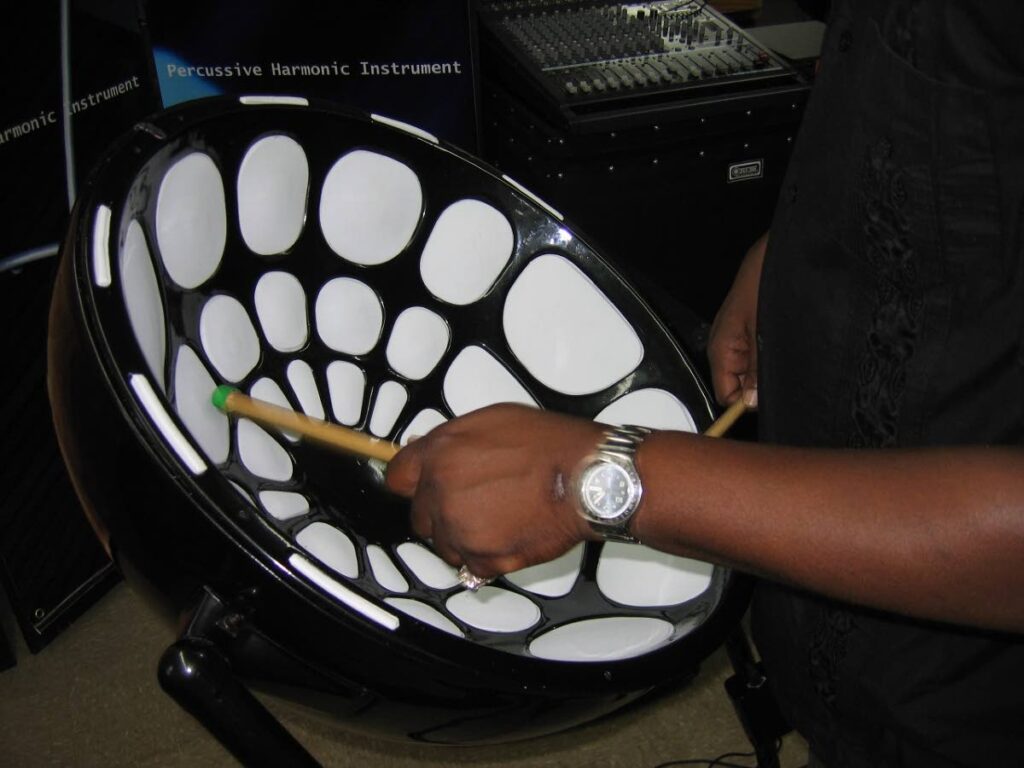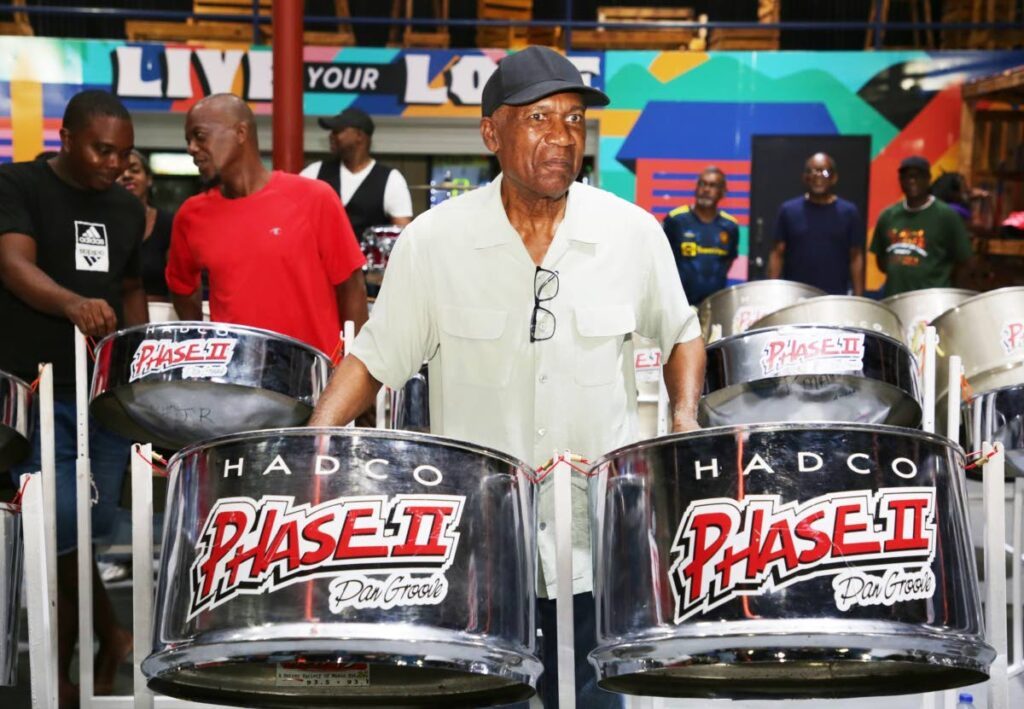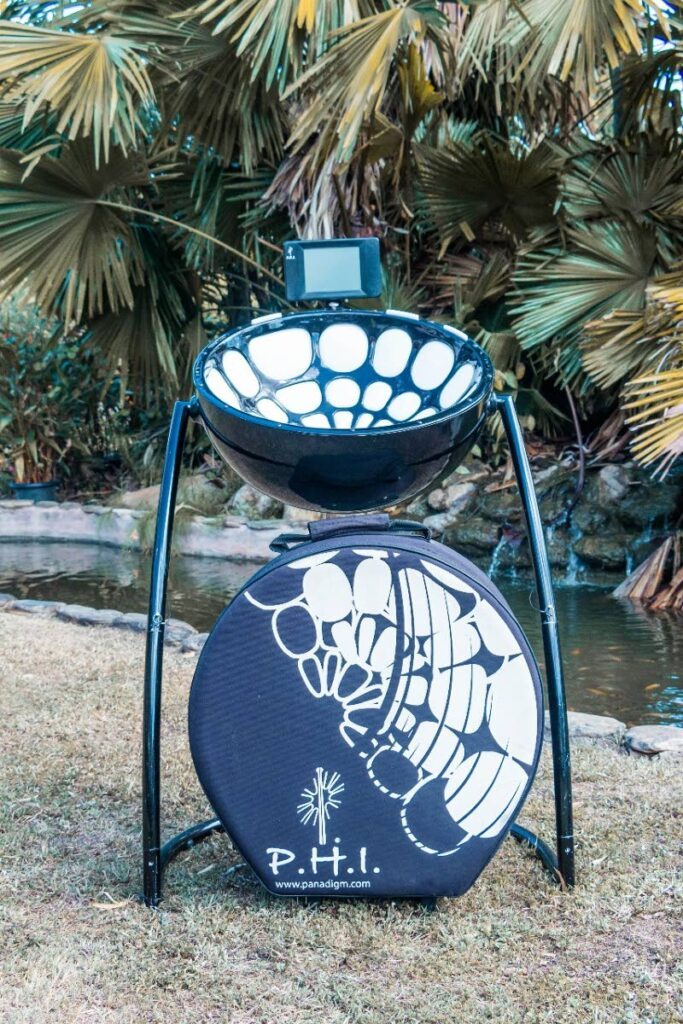Pan in PHI minor: Copeland on how new innovation will revolutionise music

THE story of how Prof Brian Copeland got together a team of 17 people to develop a steelpan innovation – the percussive harmonic instrument, or PHI – is an inspiring tale of how ordinary people can create history by simply refusing to give up.
After investing more than 20 years into their passion project, which has been fraught with challenges, including an infamous 2011 lawsuit, Copeland and his now significantly smaller team are hoping to launch PHI on the test market in June 2024, through their company Panadigm Innovations Ltd.
PHI is the most recent development in the pan, the only percussion instrument developed in the 20th century.
With the support of UWI, St Augustine, the current three-member team – Copeland, Jeevan Persad and Marcel Byron – are optimistic that by January next year, the decades of gruelling work they put into PHI will not have been in vain, as they intend to mass-manufacture the pan for local, regional, and international customers.
In an interview with Business Day, Copeland said despite low resources and the high overhead cost of moving the project forward, they will do what is necessary to eventually attract investors.
“We have to verify the market and we do that by doing a limited production. Because it is early, the cost is going to be high…We then look at that market and see if we are going to ramp up, stay level or roll it down…so we have an idea of how many we want to produce in a first batch.
“We are looking at high-grade parts…it’s a powerful engine we have in here. That early venture will tell us where the market is and the potential, so we can now go to an investor and tell them this is what we have....I think this is a very strong product and some investor will bite into it.”
What makes PHI different from the traditional pan or another Copeland invention, the G-pan? Copeland says it's PHI’s electrical engineering, which encapsulates the functions of an electronic keyboard.
“The PHI is completely electronic…the equivalent of the electronic keyboard. It’s really a synthesizer in pan form. Once you go electronic, you can do so many things.
“We do not view PHI as a pan but a completely new musical instrument motivated by the physical form of the traditional tenor pan and powered by digital technology.”

With many of its electronic components imported from Ukraine, Copeland said he is keeping his fingers crossed that the current Ukraine-Russia war does not interfere with their ambitious launch goal, as he believes this invention has the potential to revolutionise TTs steelpan industry.
The genesis of PHI
PHI was first unveiled to the public in 2007, but Copeland said the instrument had its genesis when Keith Maynard, then a Cariri employee, developed the first prototype of the electronic pan in the 80s. Maynard recommended a new technology at that time, MIDI (musical instrument digital interface), should be used on the pan.
There was a lull in development until 1993, when Copeland, along with some students, took the reins of the project eventually leading to the birth of the MIDI pan. Fast-forward to 2000: realising they had a good project, Copeland said he advised the team it was time to further improve on the MIDI pan, leading to the development of PHI.
Copeland said there was a lot of trial and error in creating the first PHI prototype.
“We were doing a lot of work on pan. We were doing pans that were played by computers…We made small pans, big pans and pans that were made from all sorts of materials.”
Copeland said they were looking for funding to further their pan research, to no avail.
Things started to look up when he received a call in 2005 from then prime minister Patrick Manning’s team, saying, they wanted to expand the range of notes available on the tenor pan and improve the sound quality of the inner notes, which Copeland said are "phenomenally hard" to play.
“They wanted to sort out the problem with the inner notes...You have to be a good expert to get nice sound out of it, and they wanted to see if they could ease that problem.”
Copeland said Manning wanted the re-engineered instruments for the National Steel Symphony Orchestra.
Copeland told Manning he and his team were already researching a solution for that very problem, which gave rise to the Steelpan Initiative Project – a government-funded project that cost over $25 million.
Under that initiative, the G-pan was launched on July 14, 2007 – an invention for which Copeland was awarded, in 2008, TT’s highest national award.
Copeland, who at that time was the dean of the faculty of engineering at UWI, St Augustine, also advocated for PHI’s further research and development. As a result, he said, the G-pan and PHI were developed simultaneously, as the first version of PHI was also developed in 2007.
“They were developed together. They were in the same womb. And you would be surprised how much problems translated from one to the other.
“I kept telling the Prime Minister to take hold of the opportunity. To take hold and seize pan as TT’s instrument and control the pan industry, because at the end, it doesn’t make sense if people can’t earn money from it.
“What we saw was that the G-pan, apart from an attempt to solve this technical problem, was also an attempt to solve a socioeconomic challenge we had with respect to the instrument.”
Copeland said many people remain confused about what differentiates the G-pan from PHI and cleared up those misconceptions, saying, “G-pan could only play pan sounds…I could play the G-pan on PHI by sampling the G-pan and putting it within the computer that is inside the PHI. You can bring me any instrument, I can sample it and put it in the PHI. You want to put your voice? I could sample it and put it inside there too.”
A storm of resistance
Copeland’s euphoria over the success of his G-pan invention and PHI’s development was short-lived after what he described as a “storm of resistance,” that found him entangled in a 2011 lawsuit that he believes was motivated by partisan party politics.
Four years after filing for the patent for the G-Pan and PHI, Copeland and PHI’s co-developers Keith Maynard, Earl Phillips (deceased) and Marcel Byron were sued by the then People’s Partnership government for what the attorney general at that time, Anand Ramlogan, described as the “virtual hijacking” of the G-pan and PHI inventions.

Copeland said his mother’s “march to the grave” was hastened by the court case, which he insists was completely unjustified.
“Essentially, I had signed off the G-pan to the government as its owner, and they were saying I should have done that with PHI.
"The government did not commission this project, as it was happening way before the G-pan…
“I thought all was needed was a discussion, but it blossomed and blew up. My name get called. People called me ‘ole thief' and so on…”
“I saw the game that was being played.”
Copeland said at the time of the lawsuit, he and his team were in talks with Trinidadian-born rap superstar Nicki Minaj to break PHI into the US market after the instrument was featured within the first three seconds of Minaj’s Pound The Alarm music video, which garnered over 288 million views on YouTube in 2012.
But the legal scandal killed that dream before it could take off.
“That case just killed everything. No investors would come. We were working with Nicki Minaj’s people. When they saw it (PHI), they stayed back…we showed them our business plan and showed them the real value of this. We told them we wanted the US market and they could have the rest.
"Then, when the case hit, quiet!”
Copeland said the trial took a mental, emotional and financial toll on him. He revealed he broke down the day the project shut down in 2013 and his team, which included 17 young people, had to abandon the project they had been passionately working on for about a decade.
“How do you distinguish a developing nation from a developed one? This was creating a business from almost nothing.
“That was the day I cried. I literally cried.”
Jeevan Persad who was a part of that original team told Newsday the experience left him heartbroken.
“Pan is one of our flagship symbols. You always talk about what is Trinidad doing for pan. How are we representing ourselves on the worldwide stage?
"And this felt as though it was a real meaningful initiative that was pushing things forward in a demonstrable way…Being part of that was extremely inspirational.
"When it broke up, it was utterly painful and heartbreaking.”
Marcel Byron, who was also embroiled in the lawsuit, said at first, he was very excited to be a part of the project, “about the electronics and actually building something from scratch for Trinidad, so I dove straight into it. It was a team spending long days and late nights together…It was fun.”
Byron did not cope well after the project was shut down.
“Honestly, I really didn’t process that period…I can’t tell you the details. Maybe that’s my way of dealing with that trauma.”

Photo courtesy Prof Brian Copeland -
Copeland said eventually they signed a mediation agreement resulting in the TT government being registered as the patent owners of the G-pan. UWI has ownership of the intellectual property for PHI and all four of PHI’s inventors are registered under the patent. Brown is the youngest of that patent-registered group.
Copeland said, “We signed a mediation agreement. Earl was sick. I actually had to sign for him. I was running out of cash. We left it as is.”
Considering the inventions were made at the steelpan research lab of UWI, St Augustine’s engineering department, Copeland, who was also campus principal, expressed his disappointment with the university, saying, “because they didn’t seem to even want to try to assist with support, despite the fact that the judge said, ‘You need to be involved, UWI.’ It was developed here and I had written to them several times telling them to come and see what we are doing here, and it never happened.”
PHI is the future
Persad told Business Day PHI allows pannists to be part of the digital ecosystem.
“How does a pannist participate in this digital world, where we’re telling them that they can go on Spotify…but we don’t have the tools for them to participate in this kind of space? We needed a product where you could play and it would score directly digitally.”
PHI has six presets so you can set up the instrument to do anything you want too.
Explaining some of its features, Copeland said, “On it is a tenor pan, middle pan, bass pan, then piano. There is a marimba and a sitar…And then more options are available if you connect a computer to it.
“If you want to do effects, you can stick a pedal in and you can modulate all kinds of stuff with it.” Anything you can do with a keyboard you can do with PHI.”
Those features, coupled with PHI’s ability to connect to a computer and play music, which can be recorded and simultaneously have that music score produced, make it the perfect instrument for pan arrangers to compose easily.
Legendary panman Len “Boogsie” Sharpe, who has won seven Panorama titles as an arranger, told Business Day while he appreciates the novelty of PHI, he doesn’t see the innovation fully infiltrating the local steelband industry. But he did agree with Copeland that PHI can be a useful tool for pan arrangers.
“I think it is for recording purposes…The steelband is in its own class by itself. PHI is for a man who want to learn to arrange or is arranging his own music.”
Sharpe said having an entire steelband in one instrument was incredibly convenient and would be beneficial for his fellow arrangers.

Photo courtesy Prof Brian Copeland. -
“I was very interested when they told me about it, because the PHI giving you the tone of the tenor, you can get guitar, double guitars or cello tones and even bass, so it’s like a one-man band…it fascinated me.”
Sharpe has several arrangements posted on YouTube using the PHI.
Copeland said his team is moving forward with their innovation, with no support from Pan Trinbago, as “their focus is the traditional pan.”
There's a silver lining though – UWI is finally fully supportive of the project and in 2020, they received some funding.
“UWI has seen the value of the project but it’s not the best place to develop. I was principal so I can say it. UWI is also a growing environment and part of the lesson was you know it’s not just about teaching and research. If the research has no impact then it’s just sitting on a shelf...What is your responsibly as a university? We have to fill the gap.”
Copeland said there is no innovation without entrepreneurship.
“For me personally, theoretically you have not innovated if you haven’t sold one. So, sell one. Get it out there.”
He said PHI will be retailed for about $1,500-$2,500 which he believes is a fair price, as customers would be getting “more bang for your buck.”
“I think PHI is the future for TT.
“We have to take control of pan technology, and that will give us control of the market for pans. Most of the pans in the world need to be coming from TT. It being born here, that is part of your marketing strategy.”
Copeland said there is a sense internationally that TT is the place for steelpan, and that reality needs to be fiercely protected.
“We have to hold on to that. It could disappear in a moment, because there are good players out there.
“Look at the whole evolution of pan, where it came from. The spirit of the pan is here.”


Comments
"Pan in PHI minor: Copeland on how new innovation will revolutionise music"